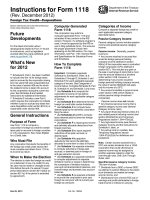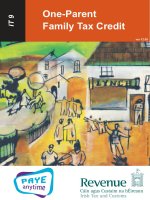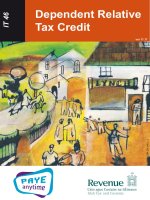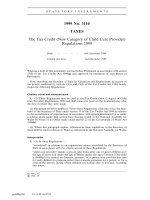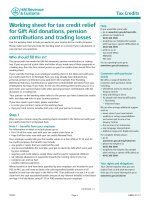Home Carer Tax Credit doc
Bạn đang xem bản rút gọn của tài liệu. Xem và tải ngay bản đầy đủ của tài liệu tại đây (525.17 KB, 7 trang )
Home Carer
Tax Credit
IT 66
RPC001278_EN_WB_L_2
ver 12.04
Introduction
The home carer tax credit may be claimed by a couple in a marriage
or civil partnership where one spouse or civil partner (the “Home
Carer”) cares for one or more dependent persons. If the home
carer has some income in their own right, the tax credit may still be
claimed. Only one tax credit is due irrespective of the number of
persons being cared for.
This leaet outlines the conditions which must be met to claim the
tax credit and also contains a claim form to enable you make your
claim.
What are the conditions?
The conditions, which must be met, are as follows:
w The couple in a marriage or civil partnership must be jointly
assessed to tax - it does not apply where couples are taxed as
single persons.
w The home carer must care for one or more dependent persons.
A dependent person is:
(a) a child for whom Social Welfare Child Benet is payable - this
includes all children under 16 and children in full-time
education under 18, or
(b) a person aged 65 years or over, or
(c) a person who is permanently incapacitated by reason of
mental or physical inrmity.
A dependent person does not include a spouse or civil
partner.
w The dependent person(s) must normally reside with the couple for
the tax year. For rules regarding relatives, see further on.
w The Home Carer’s income must not exceed €5,080 in the tax
year. Where the income is between €5,080 and €6,700 (€6,620
for the year 2007 and €6,880 for the years 2008 to 2010 incl.)
some measure of relief will still be given.
Does a relative have to reside with the Home Carer?
No. Dependent persons who are relatives (including relatives of a
spouse or civil partner) can be cared for outside the home, if they
reside:
w next door in a neighbouring residence, or
2
w on the same property, or
w within 2 kilometres of the claimant.
There must, however, be a direct communication link (e.g. telephone,
alarm system) between the two residences. A relative includes a
relative by marriage or civil partnership or a person for whom you act
as a legal guardian.
How does the income of the Home Carer affect the tax credit?
If the home carer earns income of up to €5,080 in their own right for
the tax year, the full tax credit may be claimed. For the purposes of
this tax credit, income means any taxable income such as income
from a part-time job, dividends, etc., but does not include the
Carer’s Allowance payable by the Department of Social Protection.
Note: Even though Carer’s Allowance is not taken into account in
assessing your eligibility for home carer tax credit, it is a taxable
source of income and you should notify your Revenue ofce of the
amount you are receiving.
However, if the income exceeds €5,080 the tax credit is reduced by
one half of the income of the home carer that exceeds this limit.
For example:
Income of
Home Carer
Tax Credit
Due
Restriction of Tax Credit
€5,080 €810
€5,250 €725 €5,250 - €5,080 = €170 ÷ 2 = €85
€5,500 €600 €5,500 - €5,080 = €420 ÷ 2 = €210
€5,750 €475 €5,750 - €5,080 = €670 ÷ 2 = €335
€6,000 €350 €6,000 - €5,080 = €920 ÷ 2 = €460
€6,250 €225 €6,250 - €5,080 = €1,170 ÷ 2 = €585
€6,500 €100 €6,500 - €5,080 = €1,420 ÷ 2 = €710
€6,600 €50 €6,600 - €5,080 = €1,520 ÷ 2 = €760
€6,700 €0 €6,700 - €5,080 = €1,620 ÷ 2 = €810
If the income is €6,700 for the year 2011 (€6,620 for 2007 and €6,880 for
the years 2008 to 2010 incl.) or more then the home carer tax credit is
not due.
3
What happens if the tax credit is granted and in the next year
the Home Carer’s income exceeds the limit?
If the home carer’s income exceeds €6,700 in the next year, the tax
credit will still be due for the year, provided that:
w the other conditions for the tax credit are met, and
w the tax credit was granted for the immediately preceding tax
year.
The amount of the tax credit is restricted to the amount granted for
the immediately preceding tax year. However, if the couple claim the
increased standard rate band for dual income couples, the home
carer tax credit will not be due.
Example A couple in a marriage or civil partnership are granted
the home carer tax credit for 2010. In 2011 the home
carer takes up employment and earns €7,000. The tax
credit will still be due for 2011, provided that the
increased standard rate band for dual income couples
is not claimed and the other conditions for the tax credit
are met.
Can couples in a marriage or civil partnership claim both the
Home Carer Tax Credit and the increased Standard Rate Band
for dual income couples?
No. But they can claim whichever of the two is more benecial. In
practice, Revenue will grant the more benecial treatment.
Note: For 2011, the standard rate band for dual income couples in
a marriage or civil partnership is €41,800 subject to an increase of
up to €23,800. The increase is limited to the lower of €23,800 or the
amount of the income of the spouse or civil partner with the smaller
income. This increase is not transferrable between spouses or civil
partners.
Example 1 Home carer has no income. Therefore home carer tax
credit of €810 is due.
4
Example 2 Home carer has a social welfare pension of €5,500.
Therefore home carer tax credit of €600 is due
i.e. €5,500 - €5,080 = €420 ÷ 2 = €210 restriction
€810 less €210 = €600 home carer tax credit
Spouse or civil partner has income of €30,000. The
increased standard rate band is not relevant as the
combined incomes are below €41,800.
Example 3 Home carer has rental income of €5,000. Spouse or
civil partner has income of €37,000. Calculate whether
the home carer tax credit or the increased standard
rate band is more benecial.
Home Carers Tax Credit computation
Home carer’s income is less than €5,080 so the full tax
credit of €810 is due. The tax position is:
€41,800 x 20% = €8,360
€200 x 41% = €82
Total €8,442
Less Home carer’s tax credit €810
Tax (before relief for personal tax credits) €7,632
Increased Standard Rate Band computation
The tax position is:
€42,000 x 20% = €8,400
Tax (before relief for personal tax credits) €8,400
The Home Carer tax credit is more benecial in this example.
Example 4 Home carer has a salary of €8,000. Spouse or civil
partner has income of €38,000. The home carer tax
credit is not due as the home carer’s income exceeds
the limit of €6,700.
5
Example 5 Home carer has investment income of €6,000. Spouse
or civil partner has income of €41,700. Calculate
whether the home carer tax credit or the increased
standard rate band is more benecial.
Home Carer Tax Credit computation
Home carer has investment income of €6,000.
Therefore home carer tax credit of €350 is due,
i.e.
€6,000 - €5,080 = €920 ÷ 2 = restriction €460
€810 less €460 = tax credit €350
€41,800 x 20% = €8,360
€5,900 x 41% = €2,419
Total €10,779
Less home carer tax credit €350
Tax (before relief for personal tax credits) €10,429
Increased Standard Rate Band computation
The tax position is:
(€41,700 + €6,000) x 20% = €9,540
Tax (before relief for personal tax credits) €9,540
The increased standard rate band is more benecial in this example.
How do I make a claim?
The home carer tax credit can be claimed using any of the following
methods
Internet - You can claim over the Internet using our PAYE Anytime
service. For further details visit www.revenue.ie
Text Message - Text CREDIT PPS-number PIN CARER to 51829
(the PIN requested is the number used to access PAYE Anytime).
For example, if your PPS number is 1234567A, your PIN is 654321
and you want to claim home carer tax credit simply text to 51829:
CREDIT 1234567A 654321 CARER
Telephone - Contact your Regional PAYE LoCall Service whose
number is listed on the next page.
6
Claim Form - Complete and submit the claim form attached to this
leaet to your local Revenue ofce.
Further Information - For further information visit
www.revenue.ie or you can contact your Regional PAYE LoCall
Service whose number is listed below
w Border Midlands West Region 1890 777 425
Cavan, Monaghan, Donegal, Mayo,
Galway, Leitrim, Longford, Louth,
Offaly, Roscommon, Sligo, Westmeath
wEast & South East Region 1890 444 425
Carlow, Kildare, Kilkenny,
Laois, Meath, Tipperary,
Waterford, Wexford, Wicklow
w Dublin Region 1890 333 425
Dublin (City and County)
w South West Region 1890 222 425
Clare, Cork, Kerry, Limerick
If you are calling from outside the Republic of Ireland please
telephone +353 (1) 702 3011.
Please note that the rates charged for the use of 1890 (LoCall)
numbers may vary among different service providers.
4 year time limit - A claim for tax relief must be made within 4 years
after the end of the tax year to which the claim relates
Accessibility - If you are a person with a disability and require this
leaet in an alternative format the Revenue Access Ofcer can be
contacted at accessof
This leaet is intended to describe the subject in general terms. As
such, it does not attempt to cover every issue which may arise in
relation to the subject. It does not purport to be a legal interpretation
of the statutory provisions and consequently, responsibility cannot
be accepted for any liability incurred or loss suffered as a result of
relying on any matter published herein.
Revenue Commissioners
April 2012
7

